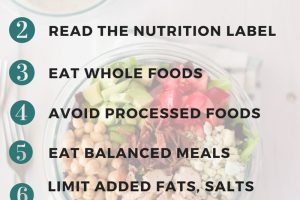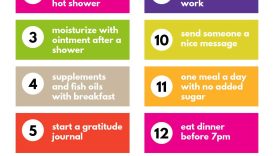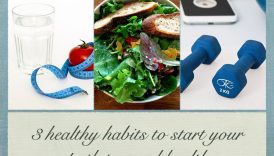Simple Tips for Eating Clean and Feeling Great

Welcome to the Clean Eating Journey
Clean eating is more than just a diet; it’s a lifestyle choice that emphasizes whole, unprocessed foods. In today’s fast-paced world, we often find ourselves reaching for convenience over health. But imagine feeling energized, healthy, and in tune with your body. This is where clean eating can transform your life. Many individuals, including my friend Sarah, decided to embark on this journey after feeling sluggish and unhappy with their eating habits. By choosing to focus on clean foods, she discovered a whole new world of flavors and nutrients. Here’s what clean eating encourages:
- Simple Tips for Eating Clean and Feeling Great
- Welcome to the Clean Eating Journey
- Understanding Clean Eating
- What is Clean Eating?
- Benefits of Clean Eating
- How to Start Eating Clean
- Setting Realistic Goals
- Planning Healthy Meals
- Essential Clean Eating Tips
- Reading Food Labels
- Avoiding Processed Foods
- Incorporating Whole Foods in Your Diet
- Importance of Whole Foods
- Easy Ways to Include More Whole Foods
- Staying Consistent with Clean Eating Habits
- Meal Prepping
- Overcoming Temptations
- Drinking Plenty of Water
- Hydration Benefits
- Tips for Drinking More Water
- Mindful Eating Practices
- Eating Slowly
- Listening to Your Body's Hunger Cues
- Focusing on Whole Foods: Incorporating fruits, vegetables, whole grains, and lean proteins into meals.
- Limiting Processed Ingredients: Steering clear of additives, preservatives, and refined sugars.
- Listening to Your Body: Understanding when you’re truly hungry versus eating out of habit.
Starting this journey might seem overwhelming, but it doesn’t have to be. In the upcoming sections, we will guide you through understanding clean eating, setting practical goals, and making it a sustainable lifestyle choice.
Understanding Clean Eating
What is Clean Eating?
Clean eating revolves around a simple principle: prioritize whole foods while minimizing processed items. It encourages individuals to choose fresh, nutrient-dense options that nourish the body. This means saying goodbye to packaged snacks and hello to colorful fruits, vibrant vegetables, and wholesome grains. For instance, when my cousin transitioned to clean eating, she discovered how to whip up delicious meals with quinoa, roasted veggies, and grilled chicken, leaving her feeling full and satisfied.
Benefits of Clean Eating
The benefits of embracing clean eating extend beyond simply losing weight. Here are a few key advantages:
- Improved Energy Levels: Clean foods provide the vitamins and minerals necessary for vitality.
- Better Digestion: Whole foods rich in fiber promote a healthy digestive system.
- Enhanced Mood: Nutrient-rich meals contribute to better mental well-being.
- Weight Management: Focusing on whole foods can help control cravings and promote sustainable weight loss.
Sarah, who started clean eating six months ago, noticed not only a physical transformation but also an increased sense of clarity and focus throughout her day. As you delve deeper into this journey, the benefits of clean eating will become more apparent, positively influencing your overall lifestyle.
How to Start Eating Clean
Setting Realistic Goals
Embarking on a clean eating journey can feel daunting at first. One of the most effective ways to begin is by setting realistic and achievable goals. Instead of making drastic changes overnight, consider the following tips:
- Start Small: Aim to incorporate one clean meal per day initially, gradually increasing as you feel comfortable.
- Specific Targets: Instead of saying “I will eat healthier,” try “I will include at least two servings of vegetables in my dinner.”
- Track Progress: Keeping a food journal helps you stay accountable and visualize your journey.
For example, my friend Alex started with the goal of swapping out sugary snacks for fresh fruit. In just a few weeks, he felt more energetic and confident in his choices.
Planning Healthy Meals
Meal planning is a game changer in the world of clean eating. Creating a structured plan not only saves time but also ensures you stay committed. Here’s how to effectively plan your meals:
- Prepare a Weekly Menu: Outline your meals for breakfast, lunch, and dinner, selecting clean recipes that excite you.
- Make a Shopping List: Use your menu to create a grocery list, focusing on whole foods and reducing the temptation of processed items.
- Batch Cooking: Prepare larger quantities of meals to enjoy throughout the week, minimizing the chance of reaching for unhealthy options.
By taking these steps, you will find that clean eating becomes not only enjoyable but also manageable, setting a solid foundation for your health journey.
Essential Clean Eating Tips
Reading Food Labels
Understanding food labels is crucial when embarking on a clean eating journey. Many people overlook this important step, often leading to unintended choices. When strolling through the grocery aisles, take the time to examine the labels. Here’s what to look for:
- Ingredients List: Prioritize foods with fewer, recognizable ingredients. If there are chemicals and additives you can’t pronounce, it’s best to avoid them.
- Nutritional Information: Pay attention to serving sizes and check the amount of sugar and sodium. Look for options that are lower in added sugars and sodium.
- Where’s the Fiber? Seek out snacks and meals that have a good amount of fiber, as this helps with digestion and keeps you feeling full longer.
For example, last year, my sister decided to switch to whole grain bread. She was surprised to discover it was often lower in sugar than the white bread she previously bought.
Avoiding Processed Foods
Processed foods are often packed with unhealthy additives, sugars, and fats. Avoiding these can go a long way in achieving your clean eating goals. Here are some practical strategies:
- Stay Whole: Focus on purchasing fresh fruits, vegetables, grains, and proteins. The fewer the processing steps, the better!
- Choose Raw Snacks: Instead of chips or sugary bars, opt for nuts, seeds, or homemade energy balls.
- Cooking at Home: Preparing meals from scratch allows you to control the ingredients, steering clear of unwanted additives.
When my friend Emma began avoiding processed foods, she was amazed at how much better she felt, both physically and mentally. In addition, this helped her find joy in cooking, as she experimented with fresh ingredients.
Incorporating Whole Foods in Your Diet
Importance of Whole Foods
Whole foods are the cornerstone of a clean eating lifestyle. These foods, minimally processed and free from artificial ingredients, provide the essential nutrients your body needs. They help improve overall health, enhance energy levels, and reduce the risk of various chronic diseases. For instance, when my co-worker, Jenna, included more whole foods in her diet, she noticed improved digestion and a clearer mind. Here’s why whole foods are vital:
- Rich in Nutrients: Whole foods, such as fruits, vegetables, whole grains, and lean proteins, are packed with vitamins, minerals, and fibers.
- Natural Energy: These foods provide sustained energy without the sugar crashes associated with processed items.
- Weight Management: Their high fiber content keeps you full longer, aiding in weight control.
Easy Ways to Include More Whole Foods
Incorporating whole foods into your diet doesn’t have to be difficult. Here are a few simple strategies:
- Start Your Day Right: Opt for oatmeal topped with fresh fruits instead of sugary cereals.
- Snack Smart: Keep raw nuts, seeds, and fresh fruit on hand for healthier snacking options.
- Experiment with Recipes: Try new recipes featuring whole grains like quinoa or barley as a base for meals.
By making these small adjustments, you’ll quickly notice the benefits of whole foods in your daily routine, just as Jenna did. It’s all about enjoying the process and discovering new favorites along the way!
Staying Consistent with Clean Eating Habits
Meal Prepping
Consistency is key when it comes to clean eating, and meal prepping can play a significant role in achieving that. Preparing your meals in advance not only saves time during the busy week but also reduces the likelihood of reaching for unhealthy options. When my friend Mark started meal prepping, he turned his chaotic evenings into a stress-free routine. Here’s how you can get started:
- Choose a Day: Dedicate a specific day, like Sunday, to plan and prep your meals for the week.
- Batch Cooking: Make larger portions of healthy recipes, like stews or salads, and divide them into individual containers.
- Variety is Key: Rotate different ingredients and flavors each week to keep your meals exciting.
Overcoming Temptations
Temptations are a natural part of any lifestyle change. However, there are strategies to help you stay focused. For instance, when Sarah faced cravings for her favorite chips, she found healthier alternatives.
- Keep Healthy Snacks Available: Stock your pantry with whole-grain crackers or air-popped popcorn.
- Mindset Change: Recognize cravings as temporary and distract yourself with a hobby or activity.
- Involve Friends and Family: Having a support system can help you stay accountable.
By employing these techniques, staying consistent with your clean eating habits becomes much more manageable, and it can lead to a lasting positive impact on your health.
Drinking Plenty of Water
Hydration Benefits
Staying hydrated is an essential aspect of clean eating that often gets overlooked. Drinking plenty of water not only quenches your thirst but also offers numerous health benefits. For instance, my friend Emily found that increasing her water intake significantly improved her energy levels and focus throughout the day. Here are some key hydration benefits to consider:
- Improved Digestion: Water aids in digestion and helps prevent constipation by keeping things moving in your digestive tract.
- Enhanced Skin Health: Staying hydrated can lead to clearer skin and a more youthful appearance.
- Weight Management: Sometimes, our bodies confuse thirst with hunger. Drinking water can help curb unnecessary snacking.
Tips for Drinking More Water
Incorporating more water into your daily routine doesn’t have to be a chore. Here are some practical tips:
- Set Reminders: Use phone alarms or apps to remind you to drink water throughout the day.
- Flavor It Up: Add slices of lemon, cucumber, or mint to your water for a refreshing twist.
- Carry a Water Bottle: Keep a reusable water bottle nearby to make drinking water accessible and convenient.
By making these small adjustments, staying hydrated will become second nature, just like clean eating itself. You’ll feel the positive effects in no time!
Mindful Eating Practices
Eating Slowly
Incorporating mindful eating practices into your clean eating journey can significantly enhance your relationship with food. One of the most effective methods is to eat slowly. When my friend Lisa started this practice, she discovered that she enjoyed her meals more and felt satisfied with less food. Eating slowly allows your body to properly digest food and signals when you’re full. Here are some tips to help you slow down:
- Put Down Your Fork: Take breaks during your meal to pause, chew, and appreciate the flavors.
- Engage Your Senses: Focus on the taste, texture, and aroma of what you’re eating, which can make the dining experience more enjoyable.
- Set a Timer: Give yourself a specific time for each meal, encouraging you to savor each bite.
Listening to Your Body’s Hunger Cues
Another important aspect of mindful eating is tuning into your body’s hunger cues. Instead of eating out of habit or boredom, pay attention to what your body truly needs. For instance, when I learned to recognize my body’s signals, I started distinguishing between actual hunger and emotional cravings.
- Check In Before Eating: Ask yourself if you are truly hungry or if you are just bored.
- Eat When Hungry: Allow yourself to eat without guilt when you feel genuine hunger.
- Pause During Meals: Stop halfway through your plate and assess whether you’re still hungry or satisfied.
By practicing these mindful eating techniques, you can cultivate a more intuitive relationship with food, making your clean eating journey even more fulfilling.




